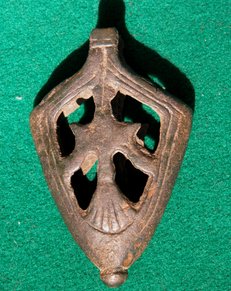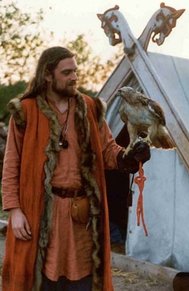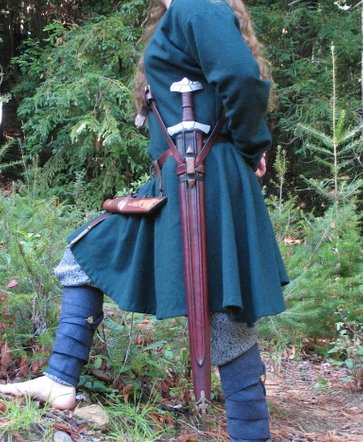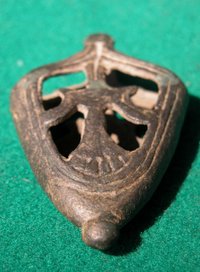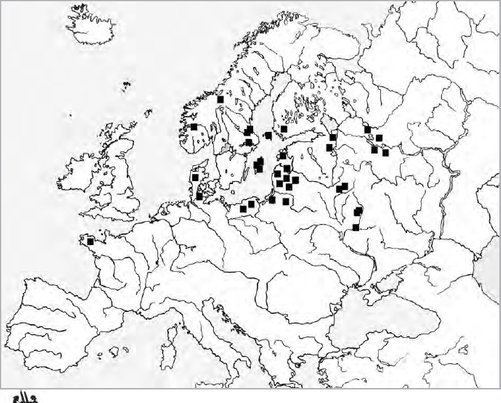January 13th 2015
Viking sword chape with falcon
This week I like to show you a viking sword chape of eastern type. With 'eastern type', this type of sword chape is addressed to the kind of sword chapes mainly found (south)east from Norway.
The image is a representation of a bird in bronze within a scabbard or sword chape. Similar motif are among the exeptional finds from the so called 'Birka excavations' wich took place between 1990 - 1995. The bird images have been identified as falcons (and not, as the salesman of this sword chape was adressing it as one of Odin's raven..).
Motifs of this kind are not exclusive to scabbard chapes and are found on other artifacts from the late Viking Age such as coins, keys, and other forms of metalwork.
Such objects are often linked with the early principality of Russia and the motif has been interpreted as an emblem or coat of arms of Rurik's kin in Novgorod and Kiev. The motif may derive from the Edda, in wich Odin's wife, Frigg, is able to take on the guise of a falcon and fly over the world. The mythical saga motif is thought to have become combined with the aristocratic hunting falcon, producing toem images and coats of arms for one of the leading princely families of Northern Europe.
The sword chape of falcon type imaged here is said to have been found in York. Nevertheless I do not have 'hard evidence' for this, and if found in York, it would represent a unique find of this kind of sword chape within England, as the map of the distribution pattern of these specific falcon type of viking sword chapes beneath this article shows us. With this restriction addressed, it is of course possible within itself that a sword chape made in the eastern Scandinavian area 'travelled' to England, as a sword chape with falcon type motif was found as far as in Normandy...
When showing the falcon type sword chape to Charlotte Hedenstierna-Jonson by mail, she responded:
'The chape from York is a clear Falcon-category chape. This category dates to the 10th century and have mainly been found in Viking urban centres along the Eastern trade route. York is an exception, as is a find from Bretagne. The chapes are most likely connected to warriors that participated in the network between trading centres like Birka, Staraja Ladoga, Gnezdovo, Kiev etc. They are often found in burials, which is not always the case when it comes to chapes. As chapes go they are one of the more extensive groups, but still rare in actual numbers. The motif has been called the Birka falcon as they are most numerous there. This is also the only known place of production, indicated by a mould for casting a similar chape. There was most likely production in other places but we do not know for a fact'.
References:
Björn Ambrosiani, Birka Studies Vlume 5, Excavations in the Black Earth 1990 - 1995: Eastern Connections Part One: The Falcon motif (2001) p. 11-27.
Charlotte Hedenstierna-Jonson, Rus', Varangians and Birka Warriors, chapter Falcon sword-chapes and other artefacts, p. 169 and further. See Figure 95. Scandinavian-Varangian sword-chapes, in accordance with Paulsen 1953, after Arne 1913 link to publication
Charlotte Hedenstierna-Jonson, A group of Viking Age sword chapes reflecting the political geography of the time, Journal of Nordic Archaeological Science 13, pp. 103–112 (2002) link to publication
Michaela Helmbrecht, A Winged Figure From Uppåkra. Fornvännen 107. Stockholm (2012) link to publication
Peter Paulsen, Schwertortbänder der Wikingerzeit, 1953. (available every now and then in antiquarian shops).
See p.17 1. Ortbänder mit germanischen Vogelmotiv and further: p. 22 - 29 Untergruppe b.
Esther Cameron, Sheaths and Scabbards in England AD400-1100 (British Archaeological Reports British Series) Paperback – January 1, 2000
http://www.vikingage.org/wiki/index.php?title=Sword_Scabbard_Chapes
<script>
(function(i,s,o,g,r,a,m){i['GoogleAnalyticsObject']=r;i[r]=i[r]||function(){
(i[r].q=i[r].q||[]).push(arguments)},i[r].l=1*new Date();a=s.createElement(o),
m=s.getElementsByTagName(o)[0];a.async=1;a.src=g;m.parentNode.insertBefore(a,m)
})(window,document,'script','//www.google-analytics.com/analytics.js','ga');
ga('create', 'UA-56164482-1', 'auto');
ga('send', 'pageview');
</script>
Well. I could have been with these stones until after dark, but as my wife wanted to travel on.. well.. I see you again, some day, hogback stones from Gosforth. And if you happen to be there one day, do not forget that monument on the outside...
Further on with the Cumbrian hogbacktour !
In - yes, luckily again in - St. Peter's church in Heysham, there is a truly beautiful hogback stone. The guide told us, it had been studyied by Thor Ewing, a writer, in 2000. in 'Understanding the Heysham hogback' A tenth century sculpted stone monument and its context (link), Thor Ewing tells in detail what he dicovered on the both sides of this hogback stone.
Just being brought in the church as late as the 1970's accompanied with some protest here and there among the church visitors, considered as being a token of old paganism, it had been remarkably nice preserved, and a lot of detail can be seen, still. Truly worthwile a visit.
I had a small debate with the guide in the church if the - zoomorphic, in my opinion - faces on the sides were lions (or hippo's). The guide doubted if the vikings could have known about lions. Well I guess so, concerning the runes on the Ancient Greek lion statue at the Arsenal, Venice. For example. Vikings did travel south..
But when he told me he was doubting the vikings 'discovered' (as the native inhabitants were of course, in the first place) America before Columbus, I decided to rest my case..
One has to know when to start and to end a conversation ..
Just discovered the book in a bookstore written by Geoff Holder - The guide to the mysterious Lake District, I knew there had to be another hogback stone in Lowther, St. Micheal's Church. With a promising image described in the text of 'a naval and a land-based force of shield-bearing vikings above a fish and what might be a coiled sea serpent. On the reverse is a row of female figures with snakes, possibly a representation of the hideous hag Hel'. Wow. If that did not sound as a true pagan promised land ..
Not complaing too much after all we have seen, this visit was the dissapointing one of them all. But if you wife states 'I am happy to have seen them' and I am answering 'Measuring is knowing' and the even more obligate verb 'handling 'if we did not see it at all, we wouldn't have known anything at all of how they were looking' the glass was again half full, at the last day of our journey..
The hogback stone appeared to be just being tolerated within the entrance segment part of the church. As something you never use anymore but you do not throw away - entirely. That sort of feeling emerged when seeing this hogback asylum seekers.. Bed, bath and bread, ás we say in Dutch, but no luxury at all and standing on some outcuts of wood, you would balance the table with at home..
Come on, St. Micheal's Church.. care a bit more of your 'children' !
This hogback stone was moved in the church in 1907. Hogback stones layed partially buried in the churchyard before it was dug up and moved into the church.
The promising depiction of a longship - as certainly can be seen after some studying - see http://vikingminds.co.uk/pages/longship
we have missed !
The stone itself is (157 x 50 x 30 cm) and very worn.
The hogback stones in Cumbria - very diverse in quality, but everyone worth a visit ! Especially on a gloomy day in late October ...
The churches to visit - see photos of resp. St. Andrew's church in Penrith, St. Mary's church in Gosforth, St. Peter's church in Heysham and St. Micheal's church in Lowther.
Did I miss out on another one in Cumbria ? Let me know !
In a next blog I will take you to four - still remaining utterly mysterious- statues 'guarding' the graveyard of St. Andrew's church in Dacre..
For the last blog of October 9th see this link.
References: (as always, links to where the books can be ordered are attached).
Edwards, B.J.N. Vikings in North West England - The artifacts (1998);
Emery, Gordon, CURIOUS CUMBRIA, The Lake District & Beyond: A celebration of Cumbria (2023)
Ewing, T. 'Understanding the Heysham hogback' A tenth century sculpted stone monument and its context ;
Hall, R. Viking Age archaeology in Britain and Ireland (first printed 1990, reprinted with amendments in 1995);
Holder, G. The guide to the mysterious Lake District (2009)
possibly also (as there within the part of Cumbria dealing with Carlisle, the Eden Valley, Barrow-in-Furness, Whitehaven and the west coast is being dealed with)
Holder, G. Paranormal Cumbria (2010)
http://vikingminds.co.uk/pages/longship
